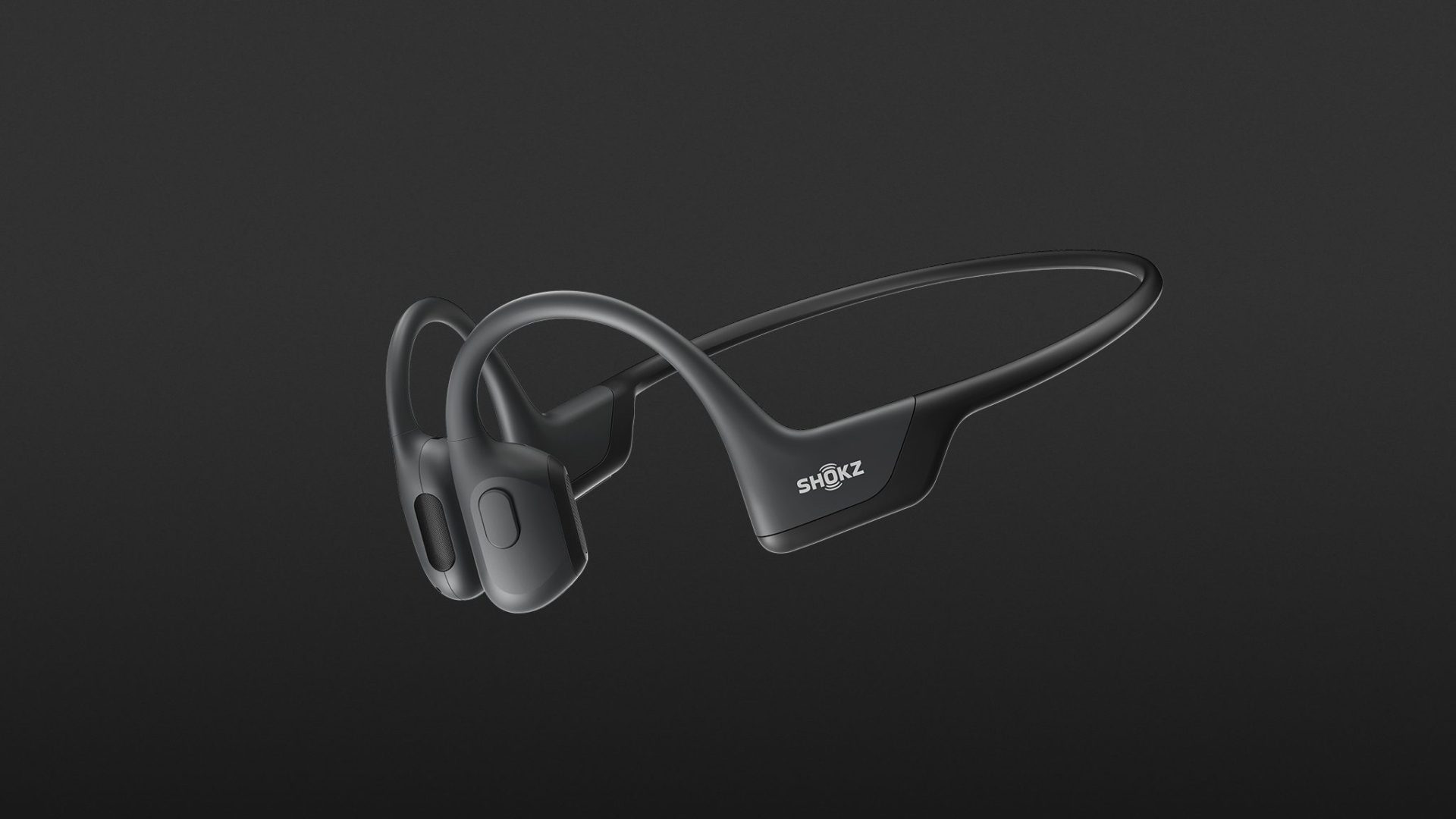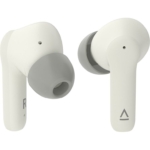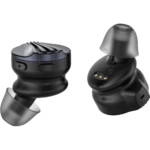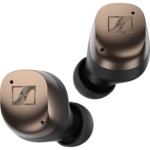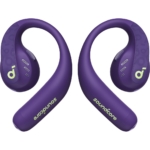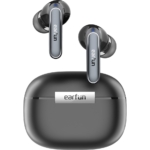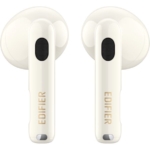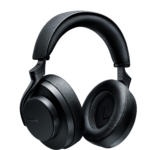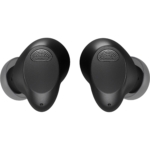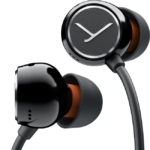Whether you’re exercising, in the office or at home, the Shokz OpenRun Pro offer an exceptional sense of freedom for your ears while providing a great deal of safety in traffic. These extremely lightweight bone-conduction earpieces are robustly built and impressed us with their good speech quality. Due to their design, you will have to live with limitations in the sound, but with their built-in bass amplifiers and “TurboPitch”, the Shokz OpenRun Pro sound better than their predecessors.
OpenRun Pro is the new top model from Shokz (formerly Aftershokz). They boast enhanced bass reproduction, a boosted battery life of up to ten hours, reworked microphones and better ergonomics. All of this looks good on paper, but how does it work in practice?
Shokz’s product portfolio makes it clear: if you’re looking for “classic” sports headphones, you are in the wrong place. This manufacturer relies entirely on so-called “bone-conduction” technology for all of its products. This technology doesn’t transmit sound via the air to the eardrum like conventional headphones but directly to the inner ear through vibrations via the cheekbones.
This offers many advantages: the ears remain completely free, allowing 100% of the environmental sound to pass through to your ears, so heat build-up, pressure discomfort, and aching ears become a thing of the past. In addition, you protect your hearing because the eardrum is bypassed.
But of course, this bone-conduction technology also has a serious disadvantage: because of the technology, the sound is not transmitted as naturally and broadly via our cheekbones as it is via normal headphones. But more on that later.
Design, technology & wearing comfort of the Shokz OpenRun Pro
Shokz OpenRun Pro are currently available in black and blue, with beige and pink to follow later.
Thanks to Bluetooth version 5.1, pairing is quick, but you won’t find any high-quality codecs here. For the OpenRun Pro, SBC is sufficient, but thanks to Multipoint, these bone-conduction headphones can pair with two devices simultaneously.
The two mini-drivers, which transmit sound to your cheekbones via vibrations, are located in the front ends of the earpieces, in front of the auricle. There are thicker structures behind the two earpieces containing the batteries and the control buttons. Everything is connected with a thin, extremely flexible titanium strap covered with rubberised plastic. However, the strap cannot be adjusted, so there’s always a slight gap between it and the back of the head.
This is not usually a problem, but it does make wearing a cap difficult. The OpenRun Pro are inconspicuous under bicycle helmets, thanks to their low weight of just 29 grams, but with dirtbike helmets and BMX helmets, the extended shell at the back of the head could cause problems. If you were riding a bike with a stretched riding position or wearing a hoody, the strap noticeably bumps against your clothing. This is somewhat annoying but rarely – if ever – affects the sound.
For runners or walkers, the Shokz OpenRun Pro fit really tightly, so nothing slips! Spectacle wearers may have to “layer”, but wearing the headphones for hours will remain pain-free.
Since the Shokz OpenRun Pro has IP55 certification, they are suitable for many sports, even if it rains. However, these headphones are not suitable for swimming. If you are explicitly looking for headphones for swimming, take a closer look at the Shokz OpenSwim (formerly AfterShokz Xtrainerz). These are IP68 waterproof up to two metres and offer an integrated MP3 player with 4 GB of memory.
Operation
If you’re already familiar with bone-conduction headphones from Shokz, you’ll be able to operate the new OpenRun Pro without looking. They have the same buttons as the smaller OpenRun model, formerly called Aftershokz Aeropex.
A larger, redesigned multifunction button is located on the left side of the casing, while the rubberised volume buttons are on the bottom behind the right earpiece. A single press of the left multifunction button starts or stops music playback and answers or ends calls. A double press skips forward one track, three presses skips back one. Fast-forwarding or rewinding within a piece of music is not possible. Pressing and holding the button calls up Siri or Google Assistant, and other combinations provide additional convenient features, such as changing the voice prompts.
Sound of the Shokz OpenRun Pro
We have already mentioned that bone-conduction headphones have weaknesses in transmission. So it’s no surprise that the Shokz OpenRun Pro sound mid-heavy, despite their stated frequency response of 20 Hz to 20 kHz.
The bass range, in particular, suffers from this type of sound transmission, and Shokz has tried to compensate for that with two additional bass amplifiers in this model. The manufacturer has certainly succeeded because the bass is undeniably there. Of course, comparisons with “normal” headphones should not be made because the Shokz OpenRun Pro would simply fail. But the OpenRun Pro are capable of reproducing everything from bass runs rich in overtones to modern sub-bass tracks. Tonality is not always provided, especially with deep synthesiser basses; in general, the bass range seems inferior.
According to the manufacturer, the OpenRun Pro offer 9th generation bone-conduction technology (Shokz calls this “TurboPitch”) which delivers a crisp and clear mid-to-high-frequency sound. This works quite well in practice, especially in the mids; podcasts or other spoken content benefit from the clarity. However, the treble falls off so that the frequency response is truncated towards the top.
When the Shokz OpenRun Pro is turned up really loud, you can feel the vibrations on your cheekbones, which may not be to everyone’s liking.
Of course, along with this technology, you have to live with a limited depth gradation that builds up in your head and not in front of it. Stereo panning (Michael Jackson’s “Thriller”), however, is clearly and comprehensibly realised.
Thanks to the built-in vocal boost mode, the sound can be tweaked towards the “voice” by pressing both volume buttons simultaneously during playback. Audrey – as Shokz calls the female voice feedback – then signals that the voice mode is active.
Battery life
Shokz OpenRun Pro offers a very good runtime of ten hours, and with the quick-charge function, you can get about 1.5 hours of playtime after a five-minute charge of an empty battery. According to the manufacturer, these bone-conduction headphones remain in standby mode for ten days when switched off. The unit is charged by magnetic induction, and the supplied cable (approx. 50 cm) magnetically attaches to the open charging contacts of the OpenRun Pro. This is an elegant solution and reminded us of Apple’s MagSafe, but losing or forgetting the cable means that the headphones cannot be charged. On the German website, you will look in vain for replacement cables, but on the English-language website, the cables are available for just under 13 US dollars, and on Amazon, you can find suitable charging cables from third-party manufacturers for around ten euros.
The battery status can be checked by pressing both volume buttons simultaneously while playback is paused. Unfortunately, in our test, this did not work reliably; we had to switch the device off and on again manually to have Audrey tell us the battery status. An automatic switch-off and a pause function would also have been desirable because, at the moment, the OpenRun Pro blithely drone on until the battery dies.
Phone calls with the Shokz OpenRun Pro
To ensure better call quality than its predecessors, Shokz has installed two microphones. The voice quality is generally good; even the caller on the end of the line had no problems understanding us. Admittedly, they could also hear passing trucks and other louder environmental noises, despite noise cancellation.
App connection
If you want to customise your Shokz OpenRun Pro, you can do so with the Shokz app (Android, iOS). Here you can control multipoint pairing, update the firmware or change the EQ modes. In addition, you can register your Shokz products, consult the user manual or read FAQs.
Technical specifications
- Ear couplingBone-conduction
- Frequency response (headphones)20 - 20.000 Hz
- Sound pressure level (SPL)105 ± 3 dB
- Weight without cable29 g
- Cable length50 cm
What's in the box
- Magnetic charging cable
- Transport case
Special features
- Available in black, blue, beige and pink
- BT codecs: SBC
- BT version: 5.1
- BT profiles: A2DP, AVRCP, HSP, HFP













